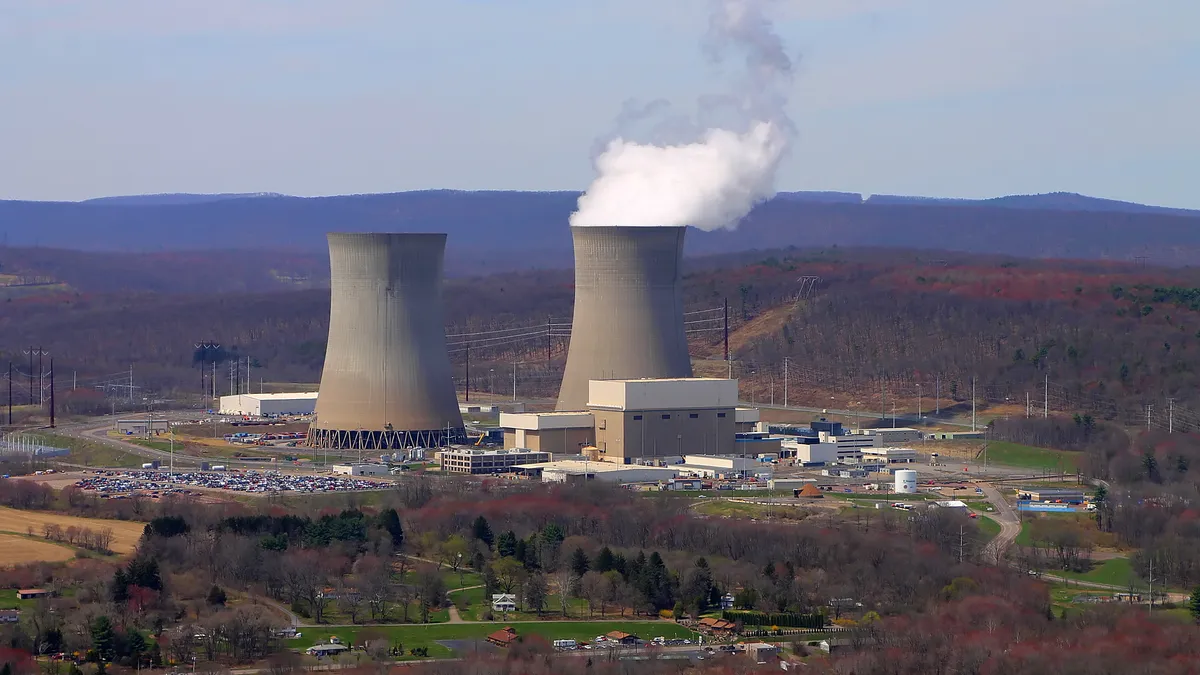Dive Brief:
-
A potentially precedent-setting proposal that would facilitate the co-location of an Amazon data center at Talen Energy’s Susquehanna nuclear plant in Pennsylvania could lead to cost shifting that harms utility customers, American Electric Power and Exelon said Monday while asking the Federal Energy Regulatory Commission to hold a hearing on the issue.
-
If FERC declines to hold a hearing, the agency should reject the non-conforming interconnection service agreement, or ISA, between the PJM Interconnection, Susquehanna Nuclear and PPL Electric Utilities, in part because it would allow the data center to take advantage of PJM’s transmission system without paying for it, according to the protest filed Monday at FERC. The ISA could shift up to $140 million in transmission costs onto other PJM customers, AEP and Exelon said.
-
“Should large quantities of load rush to co-locate with generation on terms that bear even a resemblance to the ISA at issue here, PJM capacity markets will have steadily decreasing volume as the capacity resources flee to serve load that uses and benefits from — but does not pay for — the transmission system and the ancillary services that keep the system running,” AEP and Exelon said. “This will harm existing customers.”
Dive Insight:
The questions over the ISA come as nuclear power plant owners such as Constellation and Public Service Enterprise Group are exploring selling electricity directly to co-located data centers from their power plants. The pending ISA could set a precedent for those arrangements, according to AEP and Exelon.
Talen Energy in March said it had agreed to sell a planned data center campus in Pennsylvania to Amazon.com’s cloud computing unit, Amazon Web Services, for $650 million. Talen intends to sell power to AWS from its 2,228 MW stake in the nearby Susquehanna nuclear power plant.
AWS has agreed to buy power from Talen in 120-MW increments for the data center, which could grow to 960 MW, according to Talen. It also has a one-time option to cap its commitment at 480 MW.
It would be the largest co-located load in North America, John Reed, chairman of Concentric Energy Advisors, said in testimony filed by AEP and Exelon.
On June 3, PJM asked FERC to approve an amended ISA that would allow Talen to sell 480 MW to the data center without making any transmission upgrades, up from 300 MW under the original ISA.
AEP and Exelon contend the ISA raises major issues, including some that FERC hasn’t ever reviewed.
“The implications of this case are substantial because they have the potential to fundamentally impact the regulatory landscape, influencing how regulators address cost allocation and rate design,” Reed said. “The precedent set by the modified ISA could … encourage a proliferation of co-located load arrangements, amplifying the magnitude of the associated costs and cross-subsidies.”
Under the pending ISA, the co-located data center wouldn’t be deemed “network load,” which must pay PJM transmission fees, according to AEP and Exelon. However, PJM’s tariff only defines two types of load: network load and load that pays for its own point-to-point transmission, they said.
The data center will benefit from PJM’s transmission system and should be required to pay for its share of those benefits, according to AEP and Exelon. It should also pay for its share of ancillary services and capacity, they said.
“The co-located load should not be allowed to operate as a free rider, making use of, and receiving the benefits of, a transmission system paid for by transmission ratepayers,” AEP and Exelon said.
Further, the ISA seeks to evade the results of a recent PJM stakeholder process on co-located load, according to the utility companies. During the stakeholder process, a proposal that was similar to the pending ISA garnered 16% support in a 2023 vote, according to AEP and Exelon.
The questions posed by AEP and Exelon are the types of questions regulators would want answered when considering the co-located data center arrangements, according to Tony Clark, a senior advisor at Wilkinson Barker Knauer and a former FERC commissioner.
“There may be some indication that the co-locating load is still getting some benefit from the greater grid,” Clark said Tuesday. “So then it becomes a question of how does regulation account for that and make sure that there aren't free rider issues.”
While the ISA falls under FERC jurisdiction, the AWS co-location deal also raises state issues because it involves the retail sale of electricity, which is regulated by states, he said.
“Policymakers and regulators in [regional transmission organization] regions must examine closely whether incentives inherent to organized markets are inviting a model of colocation that (i) results in unfair rate impacts to consumers, (ii) challenges reliable system operations, and (iii) promotes a ‘shell game’ for marketing rights around zero-emission electricity,” Clark and Vincent Duane, a principal at Copper Monarch, said in a mid-April white paper on co-locating data centers at nuclear power plants.















